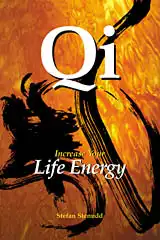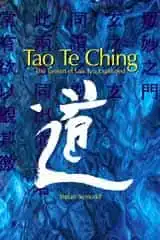|
Tao Te Ching
THE TAOISM OF LAO TZU
|
Tao Te Ching
|
The Book
The Taoism of Lao Tzu Explained. The great Taoist philosophy classic by Lao Tzu translated, and each of the 81 chapters extensively commented. Click the image to see the book at Amazon (paid link). |
The Highest Virtue
Here the focus is not on Tao, the Way, but on the second best: Te, virtue. Lao Tzu makes it very clear that virtue, although seemingly splendid, is what to follow in the absence of contact with Tao. This is true even for the very highest virtue. It's a symptom of deviation from the Way.
In our Western understanding, virtue is an old Latin concept with its roots in Ancient Greek and Roman thought. That's surely not what Lao Tzu considered in his choice of the Chinese word te. We have to examine carefully what the Chinese word might have meant to him, so that we don't automatically assume similarities with the Western concept.
But upon examination, the Chinese and the Latin words are not that far apart at all. The pictogram for te is a complex one, consisting of 14 brush strokes, which is a lot. It has three parts, each with its own separate meaning when not combined: to walk, to look straight forward, and the heart. To follow the heart in a straight walk forward.
We would think of walking the narrow road, as in Matthew 7: "The way is narrow that leads to life, and there are few who find it."
It's also quite interesting that the word Lao Tzu uses for what to do when the Way is lost, also contains the concept of walking. We have to walk through life, all of us who are born into it. How to find the correct direction? Virtue is to follow one's heart, and not deviate from this conviction.
But then we have a new problem of linguistics. Is the heart the same to the Chinese as it is to us?
In Western tradition, the word is rarely used just to point out that muscle pumping the blood around in the body. We have given the word connotations relating to emotions, ethics, conviction, and personal commitment. The Chinese have done something similar. The word is used for mind, intelligence, soul, stamina, character, and such things. Not that far from the Western use.
In short, to follow one's heart is equally commendable to the Chinese as it is to us.
For the above reasons, I dare to conclude that the Chinese word te is surprisingly near to our idea of virtue. So, virtue can be used rather safely in the translation of the Tao Te Ching. That's also the case in most translations of the book.
Virtue as a Substitute
Lao Tzu makes sense when speaking about virtue as an inferior thing to Tao itself. When we lose track, when the proper order of the universe is not evident to us, we have to trust our virtue, our sense of proper conduct. It's certainly not as safe as seeing the Way ahead of us.We get lost repeatedly, because we are easily convinced of ideals that seem right at the time, but lead us astray. We listen to words, although Lao Tzu has warned us of their shortcomings. We use a lot of words.
Holding on to virtue is to trust it more than the Way itself, when it's revealed to us. Virtue is a poor replacement for the real thing, but it can be very seductive. So, many of us hurry to decide what's virtuous and what's not, and then take pride in holding on to their course without ever questioning it. Tragedy is a very likely result, as history has shown us again and again.
When we are convinced of being virtuous, we easily lose compassion as well as common sense. It's better to regard virtue with caution, so that we immediately discover when it leads to intolerance, prejudice, cruelty, and other deviations from Tao.
Tao is infinitely yielding, but virtue tends to be quite the opposite, when we hold on to it without any questioning.
Four Steps Down
Lao Tzu presents a descent in four steps from Tao. If Tao is lost, we only have virtue to guide our steps. If virtue is lost, we should try to behave benevolently, thereby causing the least damage possible in our confusion.Benevolence needs no reason, since it acts from our hearts, our compassionate instincts. We want to do good, for no other reason than that good is superior to bad. We might not always know to separate the one from the other, but what we perceive as good we do without any other purpose.
If benevolence is lost, we turn to righteousness, but without benevolence and virtue it becomes a very risky business. Such righteousness can quickly lead to oppression and inhuman laws.
Righteousness always contains some purpose. We do this to accomplish that. The end justifies the means, although whenever this argument is put into use, it tends to lead to sacrifices surpassing the benefits of the outcome.
When even righteousness is lost, what remain are rituals – the ignorant commitment to customs and beliefs that have lost their meaning. That is mankind at its lowest, repeating things of old just because of habit, sticking desperately to outdated fragments of thoughts, as if their lack of reason were proof of their elevation. As if ignorance is bliss.
When rituals rule, force is always used to uphold them. They are not to be questioned, because there is no explanation to them. Unfortunately, it happens frequently that our society degrades to such practice.
The Folly of the Future
Lao Tzu ends the chapter with a warning about the future. Knowing it can be a splendid manifestation of the knowledge of Tao. When you are familiar with the Way, you know where it leads. But this is superficial. It's not where it leads that's important, but how the voyage is, at each small step of the Way. The present is what truly counts.The future is just another word for the outcome, which is the excuse used by righteousness, as mentioned above. If we focus on what will happen later, we allow ourselves to mess up the present. Even if our view of the future is accurate, we have no reason for staring at it. It will come, in due time.
We do much better to keep our attention on the present. That's also the safest method to ensure that we reach the future we seek.
Tao is not about the future, although it rules that, too. It's about how everything works and should work at every moment of time. To follow its fruit instead of its dazzling flower is to adapt to Tao now, not at some other time.
NEXT
Tao Te Ching Explained
Preface
Introduction
Literature
translated and explained by Stefan Stenudd.
1 |
2 |
3 |
4 |
5 |
6 |
7 |
8 |
9 |
10 |
11 |
12 |
13 |
14 |
15 |
16 |
17 |
18 |
19 |
20 |
21 |
22 |
23 |
24 |
25 |
26 |
27 |
28 |
29 |
30 |
31 |
32 |
33 |
34 |
35 |
36 |
37 |
38 |
39 |
40 |
41 |
42 |
43 |
44 |
45 |
46 |
47 |
48 |
49 |
50 |
51 |
52 |
53 |
54 |
55 |
56 |
57 |
58 |
59 |
60 |
61 |
62 |
63 |
64 |
65 |
66 |
67 |
68 |
69 |
70 |
71 |
72 |
73 |
74 |
75 |
76 |
77 |
78 |
79 |
80 |
81 |
Tao Te Ching Explained
James Legge's Tao Te Ching
Aleister Crowley's Tao Te Ching
The 1st Chapter of Tao Te Ching in 76 Versions
Lao Tzu — Legendary Author of Tao Te Ching
My Taoism BooksClick the image to see the book at Amazon (paid link).
The Taoism of Lao Tzu Explained. The great Taoist philosophy classic by Lao Tzu translated, and each of the 81 chapters extensively commented. |
About Cookies
My Other Websites:
I Ching Online
The 64 hexagrams of the Chinese classic I Ching and what they mean in divination. Try it online for free.
Qi Energy Exercises
The ancient Chinese life energy qi (chi) explained, with simple instructions on how to exercise it.
Life Energy
The many ancient and modern life force beliefs all over the world explained and compared.
Taoismen på svenska
Other Books by Stefan Stenudd
Click the image to see the book at Amazon (paid link).
 Cosmos of the Ancients
Cosmos of the Ancients
The Greek philosophers and what they thought about cosmology, myth, and the gods.
 Qi — Increase Your Life Energy
Qi — Increase Your Life Energy
The life energy qi (also chi or ki) explained, with exercises on how to awaken, increase and use it.
 Aikido Principles
Aikido Principles
Basic concepts of the peaceful martial art. Aikido principles, philosophy, and fundamental ideas.
 Life Energy Encyclopedia
Life Energy Encyclopedia
Qi, prana, spirit, ruach, pneuma, and many other life forces around the world explained and compared.
 Archetypes of Mythology
Archetypes of Mythology
Jungian theories on myth and religion examined, from Carl G. Jung to Jordan B. Peterson.
 Stefan Stenudd
Stefan Stenudd
About me
I'm a Swedish author and aikido instructor. In addition to fiction, I've written books about Taoism and other East Asian traditions. I'm also an historian of ideas, researching ancient thought and mythology. Click the image to get to my personal website.Contact

 Tao Te Ching
Tao Te Ching Tao Quotes
Tao Quotes Fake Lao Tzu Quotes
Fake Lao Tzu Quotes